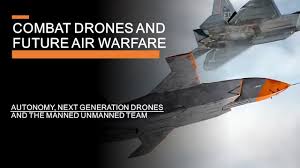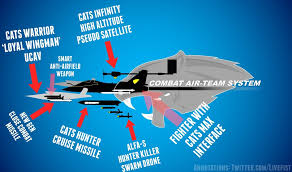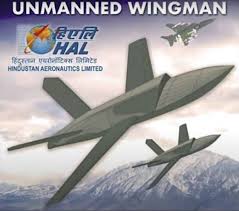The rapid advancement of unmanned aerial vehicles (UAVs), known as drones, has revolutionised modern warfare. Once primarily used for reconnaissance and surveillance, drones have evolved into sophisticated combat platforms capable of executing precision strikes, electronic warfare, and logistics support. The proliferation of combat drones challenges the dominance of traditional airpower by altering strategic doctrines, operational tactics, and force structures. This article explores the rise of combat drones and their profound implications for conventional airpower.
Armed variants of the Predator, such as the MQ-1 and MQ-9 Reaper, demonstrated the feasibility of unmanned precision strikes, ushering in a new era of aerial warfare. Since then, countries such as China, Russia, Turkey, and Iran have rapidly developed their combat drone capabilities. Technological advancements in artificial intelligence (AI), sensor miniaturisation, and autonomous navigation have expanded combat drones’ capabilities. Modern drones can operate autonomously, engage in complex swarm tactics (where multiple drones coordinate their actions in real-time), and integrate with network-centric warfare systems. A list of major combat drones is appended.
Key Advantages of Combat Drones
Combat drones, or unmanned aerial vehicles (UAVs), have rapidly transformed modern military operations. They offer a range of significant advantages that enhance strategic effectiveness and operational efficiency. These advantages are critical for established military powers and smaller nations looking to improve their defence capabilities.
Cost-Effectiveness. One of the most prominent advantages of combat drones is their cost-effectiveness. Traditional manned aircraft, such as fighter jets and bombers, involve substantial financial investments in production, maintenance, fuel, and the continuous training of pilots. These high operational and training costs make them financially burdensome, especially for nations with smaller defence budgets. Combat drones, in contrast, are much more affordable to produce, operate, and maintain. This makes drones an attractive option for military forces seeking advanced technology without the prohibitive expenses of traditional aviation.
Reduced Risk to Human Life. The ability to operate drones remotely means that military personnel are not physically present in the combat environment, which significantly reduces the risk to human life. Manned aircraft often place pilots in high-risk situations, such as hostile airspace, where the threat of anti-aircraft weapons, enemy fighters, or surface-to-air missiles is constant. This feature makes drones especially valuable for missions in high-risk zones, such as counterterrorism operations, surveillance of enemy positions, or strikes against heavily fortified targets. By minimising human casualties, drones ensure mission sustainability and allow forces to continue operations with fewer limitations.
Persistent Surveillance and Endurance. Unlike manned aircraft with limited flight durations due to fuel constraints, combat drones can remain airborne for extended periods, often hours or even days. This endurance allows drones to conduct continuous intelligence, surveillance, and reconnaissance (ISR) operations over extended periods without returning to the base for fuel or rest. Drones can loiter over targets for extended periods, tracking enemy movements, gathering intelligence, and relaying data to commanders. This constant flow of information improves situational awareness and allows military forces to remain proactive rather than reactive in their operations.
Precision Strike Capabilities. Modern combat drones are equipped with advanced targeting systems, enabling them to conduct precise strikes with high accuracy. This precision is made possible through advanced sensors, cameras, and laser-guided munitions, which enable drones to accurately identify and engage enemy targets such as vehicles, facilities, or personnel, even in complex environments. Precision is critical in counterinsurgency operations, where avoiding collateral damage is crucial for maintaining local support and reducing the risk of civilian backlash.
Operational Flexibility. Another significant advantage of combat drones is their operational flexibility. Drones are highly versatile and can be deployed in various roles, from surveillance and reconnaissance to electronic warfare and decoy operations. They can serve as support platforms for ground troops, relaying intelligence, providing airstrikes, or conducting search and rescue missions. Drones can also be used in electronic warfare, disrupting enemy communication systems or jamming radar signals. Additionally, drones can serve as decoys, drawing enemy fire or confusing adversaries about the location of critical assets. This adaptability makes drones valuable assets in numerous military operations, enhancing their utility in diverse combat scenarios.
Drone Usage in Recent Conflicts
Nagorno-Karabakh Conflict. This conflict saw extensive use of drones by Azerbaijan, which utilised both tactical drones for surveillance and loitering munitions for precision strikes. Azerbaijan’s use of Turkish-made Bayraktar TB2 drones (a medium-altitude, long-endurance tactical unmanned aerial vehicle), alongside Israeli-made drones, played a crucial role in undermining Armenian defensive positions and disrupting supply lines. Drones provided real-time intelligence and executed targeted airstrikes, significantly impacting the battlefield dynamics. The success of drones in this conflict highlighted their role in modern warfare, showcasing their effectiveness in both reconnaissance and offensive operations and marking a shift in how airpower is utilised in regional conflicts.
Ukraine-Russia Conflict. In the ongoing Ukraine-Russia conflict, drones have become pivotal for both sides. Ukraine has relied heavily on drones for intelligence, surveillance, reconnaissance (ISR), and precision strikes. The use of Turkish-made Bayraktar drones has garnered international attention due to their success in targeting Russian artillery and supply lines. Russia, in turn, has deployed both reconnaissance drones and loitering munitions such as the Lancet drone. Drones are crucial in this conflict, offering both tactical advantages in real-time battlefield awareness and as weapons of deterrence. The conflict exemplifies how UAVs transform modern armies conducting warfare on the ground and in the air.
Israel-Hamas War. During the Israel-Hamas conflict, drones played a significant role in both offensive and defensive strategies. Israel utilised advanced unmanned aerial vehicles (UAVs) like the Hermes 450 and the Heron TP for surveillance, reconnaissance, and precision strikes, targeting Hamas military infrastructure, leaders, and weapon caches. Drones enable real-time intelligence, improving the effectiveness of airstrikes while minimising collateral damage. Hamas also deployed drones, often for reconnaissance and surveillance, but with increasing sophistication in attacking Israeli targets. The conflict highlighted the growing reliance on drones for modern warfare, as they offer cost-effective, high-precision capabilities in asymmetric conflicts.
U.S. Counterterrorism Operations. Combat drones have been central to U.S. counterterrorism operations, particularly in regions like the Middle East and North Africa. The U.S. military has employed drones for targeted strikes against high-value targets, including terrorist leaders and militants affiliated with groups like Al-Qaeda and ISIS. Drones such as the MQ-9 Reaper and MQ-1 Predator have provided surveillance and precision strike capabilities without the risk of piloting manned aircraft in hostile environments. These operations, while effective in neutralising threats, have raised ethical and legal concerns about civilian casualties, sovereignty violations, and the long-term strategic consequences of drone warfare.
Future Trends in Drone Warfare
AI-Driven Autonomy. AI-driven autonomy in drone warfare will revolutionise decision-making, enabling UAVs to analyse data and execute missions independently. This reduces human intervention, enhances speed, and improves operational efficiency, allowing drones to make real-time tactical decisions and adapt to changing battlefield dynamics without relying on constant human oversight.
Swarm Tactics. Swarm tactics involve deploying many drones that can communicate and collaborate autonomously to overwhelm targets. This approach maximises impact, confuses enemies, and complicates defence strategies. Swarms can be used for offensive operations, like saturation attacks, and defensive roles, such as countering incoming threats in coordinated formations.
Hybrid Manned-Unmanned Operations. Hybrid manned-unmanned operations combine human decision-making with autonomous drone capabilities, enhancing flexibility and situational awareness. Human pilots can control UAVs while receiving support from AI systems that automate data processing and mission planning. This synergy allows for optimal control and strategic execution while reducing the cognitive burden on operators.
Miniaturisation and Stealth. Miniaturisation and stealth technologies are enhancing drones’ ability to operate undetected. Smaller, quieter UAVs with reduced radar signatures can infiltrate enemy defences, gather intelligence, or carry out strikes without being easily intercepted. These advances improve tactical flexibility and extend the operational range of drones in contested environments.
Implications of Combat Drones on Traditional Airpower
The rapid advancement and proliferation of combat drones, also known as unmanned combat aerial vehicles (UCAVs), have fundamentally reshaped the landscape of air warfare. The increasing integration of unmanned systems has now disrupted what was once a domain exclusively dominated by manned fighter jets, strategic bombers, and attack aircraft. While traditional airpower remains indispensable in major military operations, combat drones introduce new doctrines, alter strategic calculations, and challenge long-held assumptions about air superiority. From cost-effectiveness to survivability, from force projection to counter-air missions, the implications of drones on traditional airpower are profound and multifaceted.
Changes in Force Structuring. This cost-effectiveness has allowed major and minor powers to expand their air combat capabilities without requiring massive budgets. Countries that could not previously project significant airpower can now field substantial drone fleets, effectively democratising access to aerial warfare. Moreover, drone attrition is far more acceptable than the loss of a piloted aircraft, further changing the strategic calculus. Traditional airpower relies on highly trained pilots, whose combat loss affects military effectiveness and carries significant political and moral weight. The expendability of drones means that military commanders can take more significant risks, leading to more aggressive and flexible operational doctrines.
Changing the Nature of Air Superiority and Aerial Combat. The rise of combat drones challenges traditional definitions of air superiority. Historically, air superiority was determined by the ability of manned fighter aircraft to establish dominance over enemy airspace through superior manoeuvrability, advanced sensors, and beyond-visual-range (BVR) engagements. However, drones are now increasingly capable of carrying out air-to-air missions, raising questions about the future role of manned aircraft in achieving air superiority. For example, the Loyal Wingman concept, which pairs autonomous drones with manned fighter jets, represents a hybrid traditional and drone-based airpower model. In this setup, manned aircraft act as command-and-control nodes while drones perform high-risk tasks such as dogfighting, electronic warfare, and decoy operations. Similarly, China is developing drones like the FH-97, modelled after the U.S. XQ-58 Valkyrie, which can operate as autonomous wingmen to piloted aircraft.
Changes in Traditional Fighter Combat Tactics. Small, agile drones can operate in swarms, overwhelming enemy defences in ways that traditional aircraft cannot counter easily. Countries such as China and Russia are actively developing swarm drone technology that could neutralise enemy air defences and fighter squadrons by sheer numbers. In such a scenario, traditional air combat tactics based on individual or squadron engagements may become obsolete, replaced by algorithm-driven swarm warfare where AI-driven drones execute complex attack patterns beyond human reaction times.
Evolution of Air Defence Systems. The rise of combat drones has forced rapid changes in air defence systems. Traditional air defences, such as surface-to-air missile (SAM) systems, were designed to counter high-speed, high-altitude threats from fighter jets and bombers. However, drones present an entirely different challenge, as they are often smaller, slower, and fly at lower altitudes, making them difficult for conventional radar systems to detect and track. Countries have responded by integrating counter-drone capabilities into their air defence networks. Integrated air defence systems, such as Israel’s Iron Dome and Russia’s Pantsir-S1, have been adapted to target drones with high-precision missiles and rapid-fire auto-cannons. Additionally, electronic warfare (EW) has emerged as a crucial element in countering drone threats. Many modern air defence systems now incorporate jamming and spoofing capabilities to disrupt combat drones’ communications and GPS navigation, rendering them ineffective. Despite these adaptations, drones are still proving to be highly disruptive. The 2020 Nagorno-Karabakh conflict demonstrated how drones could systematically dismantle traditional air defences. Azerbaijani forces used Turkish and Israeli drones to destroy Armenian SAM sites, rendering their conventional air defence network ineffective. This shift suggests that air defence will increasingly rely on layered, AI-driven networks capable of simultaneously countering manned and unmanned threats in future conflicts.
Alteration in Roles and Tasks. Traditional airpower doctrine has been built around fighter jets for air superiority, strategic bombers for deep penetration strikes, and Battlefield air support (BAS) aircraft for ground engagements. However, combat drones are altering these roles in significant ways. In battlefield air support missions, drones have already proven their effectiveness. The MQ-9 Reaper, for example, has been widely used by the U.S. military for BAS missions in Afghanistan, Iraq, and Syria. Unlike traditional BAS aircraft requiring significant logistics and support, drones can loiter over a battlefield for extended periods, providing persistent surveillance and rapid strike capability. This persistence gives ground commanders real-time intelligence and strike options that traditional aircraft cannot match. In strategic bombing missions, drones are also beginning to make their mark. While heavy bombers like the B-52 or B-2 Spirit lack the payload capacity, swarming drone tactics could compensate by overwhelming enemy defences with multiple smaller precision strikes. China’s WZ-8 high-speed reconnaissance drone and the U.S. RQ-180 stealth drone suggest that drones may soon take over many roles traditionally assigned to strategic bombers.
Shift in Human Role. Additionally, the increasing use of AI in drone operations is shifting the human role in air warfare. While traditional airpower relies on human decision-making, AI-driven drones can process vast amounts of battlefield data in real time, react faster than human pilots, and execute missions with minimal human intervention. This shift raises ethical and operational questions about the future of autonomous air warfare, particularly in conflicts where rapid decision-making can mean the difference between victory and defeat.
The Future of Manned Aircraft in a Drone-Dominated Battlefield. While drones are rapidly transforming air warfare, it is unlikely that traditional manned aircraft will become obsolete in the near future. Instead, airpower will likely evolve into a hybrid model where manned and unmanned platforms work together. For example, the U.S. Air Force’s Next-Generation Air Dominance (NGAD) program envisions a future where advanced fighter jets operate alongside AI-driven drones in a coordinated battle network.
Evolutionary Process. Stealth fighter jets will still be critical for high-end air combat against technologically advanced adversaries. While drones offer many advantages, they still face limitations regarding autonomy, electronic warfare vulnerabilities, and adaptability in complex combat scenarios. Human pilots bring strategic thinking, adaptability, and situational awareness that AI-driven drones cannot fully replicate. That said, as AI and drone technology continue to improve, we may eventually see a shift where manned fighters become command platforms rather than frontline combatants. Future air battles may be fought with autonomous drone swarms controlled by human operators from standoff distances, reducing the need for pilots to engage in direct combat.
Conclusion
The rise of combat drones represents a paradigm shift in modern warfare, challenging the supremacy of traditional air power. While manned aircraft will likely remain relevant for the foreseeable future, their role is shifting toward command and control rather than direct engagement. As drone technology continues to advance, the future of air warfare will likely be defined not by individual dogfights but by networks of autonomous systems operating in concert with traditional manned platforms. In this evolving landscape, the key to maintaining air dominance will be successfully integrating drones into traditional airpower frameworks, leveraging human and artificial intelligence to maximise combat effectiveness.
The increasing integration of drones necessitates a revaluation of military doctrines, investment priorities, and force structures. The future of air warfare lies in a balanced approach that leverages the complementary strengths of both manned and unmanned systems.
Please Do Comment.
For regular updates, please register your email here:-
References and credits
To all the online sites and channels.
References:-
- Boyle, M. J. (2015). “The Drone Age: How Drone Technology Will Change War and Peace.” International Affairs, 91(1), 67-84.
- Horowitz, M. C., & Fuhrmann, M. (2018). “Droning On: Explaining the Proliferation of Unmanned Aerial Vehicles.” International Security, 43(2), 7-47.
- Zenko, M. (2010). “The Proliferation of Drones.” Council on Foreign Relations Report.
- Byman, D. (2013). “Why Drones Work: The Case for Washington’s Weapon of Choice.” Foreign Affairs, 92(4), 32-43.
- Gartzke, E., & Lindsay, J. R. (2019). “The Influence of Drones on the Nature of Warfare.” Security Studies, 28(2), 245-281.
- Scharre, P. (2018). “Drones and the Future of Warfare.” Center for a New American Security (CNAS).
- Mehta, A. (2021). “How China’s Drone Strategy Is Shaping the Global Military Balance.” Defence News.
- Heginbotham, E. (2019). “The Role of Unmanned Combat Systems in the Indo-Pacific.” War on the Rocks.
- Johnson, E. (2020). The Integration of UAVs in Modern Air Combat: A Strategic Perspective. [Doctoral dissertation, King’s College London].
- Thompson, J. (2018). The Changing Face of Aerial Combat: Drones Versus Manned Aircraft. [Master’s thesis, U.S. Naval War College].
- Indian Ministry of Defence. (2022). Drone Policy and Integration in the Indian Armed Forces.
- RAND Corporation. (2018). Future Unmanned Aircraft Systems: A Comparative Assessment.
- Stockholm International Peace Research Institute (SIPRI). (2021). The Impact of Military UAVs on Contemporary Warfare.
- Center for Strategic and International Studies (CSIS). (2022). The Future of Air Dominance: Evaluating the Role of Combat Drones.
Disclaimer:
Information and data included in the blog are for educational & non-commercial purposes only and have been carefully adapted, excerpted, or edited from reliable and accurate sources. All copyrighted material belongs to respective owners and is provided only for wider dissemination.



